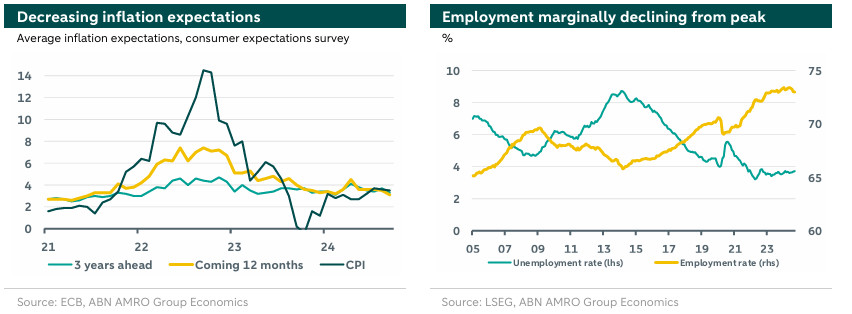The Netherlands - Bleak outlook for external demand and investment

We expect below trend growth for H2 2024, with annual growth of 0.6% for 2024 and 1.3% in 2025. Employment is marginally declining from its peak and unemployment is gradually increasing, but the labour market is expected to stay tight from a historical perspective. We have raised our house price estimates to 8.5% for 2024 and to 7% for 2025.
On 14 November, Dutch GDP figures for Q3 will be released. We anticipate a growth of 0.2% q/q, following the unexpectedly strong 1% growth in Q2, mainly due to rising exports and government consumption. Indeed, as noted before, we think that this one swallow in Q2 does not make a summer: moderate growth in H1 of the year will only be followed by modest growth for the remainder of the year. While real incomes are benefitting from high wage growth and declining inflation, consumers still seem hesitant to spend and favour saving and deleveraging. Consumer confidence fell again in October and remains below the long-term average. The silver lining is that inflation expectations have dropped further, with average expectations for the next 12 months at their lowest since June 2021. On balance, we expect a slow pickup in household spending for the remainder of the year, helped by the aforementioned tailwinds.
The outlook for external demand and private investments remains bleak. The German economy is underperforming, the broader eurozone is seeing downside economic surprises, and global manufacturing is slowing. As a trade-oriented country, the Netherlands is significantly affected by international developments, and trade is expected to contribute only slightly to overall GDP growth for the year as a whole. In terms of private investment, companies are cautious due to weaker growth prospects, geopolitical uncertainty, a tight labour market and the shaky first steps of the new Dutch government. We think that exports and investment will see significant growth next year, when interest rates are cut further, global demand strengthens and consumer demand increases.
The employment rate is declining from its peak, and unemployment rate is gradually increasing, as temporary factors – like the low number of bankruptcies coming out of the pandemic – are unwinding. In Q3, employment decreased by 0.3% compared to Q2, marking the first decline since 2020. The vacancy rate (no. of job vacancies / (employment + no. of job vacancies)) is still elevated at 3.9% compared to the pre-pandemic average of 2.1%, but has been declining since the peak of 4.6% in 2022. Nevertheless, the Dutch labour market remains incredibly tight, with the unemployment rate deeply below the estimated non-inflationary level of unemployment (the NAIRU), and total labour supply far above the pre-pandemic level. The unemployment rate is expected to remain low in the years to come due to strong labour demand and limited labour supply, given the greying population.

We have raised our house price estimates to 8.5% for 2024 (was 7.5%) and to 7% for 2025 (was 5%). The main factors behind price growth on the demand side are higher wages, as well as declining mortgage rates and the widening of lending standards. Thanks to the combination of higher wages and lower mortgage rates, buyers can take out larger mortgage sums when buying a home. The constrained supply side – in terms of limited construction – adds to price pressures. The transaction estimates for 2024 were also raised on the back of higher transactions in the year to date so far, to 12% (was 10%), whereas the forecasts for 2025 remain at 2.5%.

